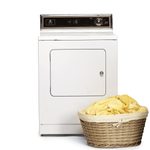Will a Ventless Washer/Dryer Combo Work for You?

Ventless washer-dryer combos save energy, are easier on your clothes and can be installed anywhere. Still, they aren't for everyone.
Our editors and experts handpick every product we feature. We may earn a commission from your purchases.
Ventless dryers are still somewhat of a novelty in North America. But in Europe, people just call them “dryers.” They’ve been popular there since the late 1990s because they’re compact and require less energy than the “hotboxes” North Americans prefer. Combine a ventless dryer with a washing machine, and you have an energy-saving combo that fits in a closet.
Sounds like a good idea, right? Well, it depends on the size of your family and how much laundry your do, says Ron Shimek, president of Mr. Appliance, a Neighborly company.
There’s a tradeoff for the higher efficiency and energy cost savings — smaller loads and longer wait times. However, for some people, it’s a blessing.
“If you are in an older home or apartment that was not built for a dryer and therefore has no outside vent,” says Shimek, “you can use a ventless dryer instead of installing a vent into the home or apartment.”
Ventless washer dryer combos are so much more efficient than standard vented ones that at least one country — Switzerland — has prohibited vented dryers. In North America, however, we’re not there yet. Here, ventless dryers tend to have small capacities, frustrating busy people with large families.
However, given the need for higher efficiency and the phasing out of gas appliances in some places, it’s a good idea to keep an eye on new products. Manufacturers have begun providing larger units with more capacity and faster drying times.
On This Page
What Is a Ventless Washer-Dryer Combo?
A ventless washer-dryer combo and a conventional one employ different technologies.
Shimek says a ventless dryer draws in cool air from the room and heats it like a vented dryer. “[But] instead of venting the humid hot air outside,” he says, “it pushes the air through a condenser loop which cools the air back down, pulling the water out of the air and draining into a storage tank.”
There’s no need for a vent because air is constantly recirculated between the tumbler compartment and the condensation chamber.
The dryer uses a refrigeration system similar an air conditioner or dehumidifier. Condensing coils in the tumbler compartment heat up the air so it can absorb moisture. Then evaporative coils in the drain area cool the air as it circulates, forcing the moisture out. The compressor driving the process uses about as much energy as a refrigerator compressor.
The washer, sharing the same compartment as the dryer, works like a conventional washing machine. It requires hot and cold water hookups and a drain shared by the dryer.
You just put in your laundry, select the wash/dry cycle appropriate for that load, and the appliance does the rest. After the washing cycle ends, the dryer starts and continues until the moisture sensor detects the clothes are dry.
A typical washer-dryer combo is a front-loading rectangular box with a capacity from 2.4 to 2.7 cubic feet, but some are larger. The GE Profile Ultrafast Combo — which won an award at the 2023 International Builders’ Show — and the Whirlpool Ventless All In One Washer Dryer both feature 4.8-cubic-foot capacity.
Ventless Washer-Dryer Combo Pros and Cons
The decision to go for a ventless washer-dryer combo isn’t a slam dunk. Although there are some obvious advantages, there are also significant drawbacks.
Pros
- Versatility: You can install a ventless washer-dryer combo anywhere with water hookups and a 120-volt GFCI receptacle. It can go in a corner of the kitchen, an alcove in the bathroom or even a closet.
- Energy savings: Combo washer-dryers can be plugged into a standard outlet — no need for a 240-volt circuit. They use as little as 40 percent of the energy of conventional units.
- Convenience: Because the unit washes and dries in a single cycle, you simply load the laundry and take it out when it’s done.
- Easy on clothes: The drier generates far less heat than a conventional one so it’s less likely to damage delicate clothing.
- Safety: There’s no ductwork to collect flammable lint, so a ventless unit less likely to start a fire.
Cons
- Cost: Ventless washer-dryer combos cost more than conventional ones and don’t last as long. The typical lifespan, according to Shimek, is eight to 10 years, versus 10 to 13 years for a conventional combo unit.
- Space: Unless you go for one of the more recent models, you’ll have half the space (or less) for your clothes than with a conventional combo.
- Longer drying times: Some units can take up to an hour longer to dry clothes than conventional dryers. Newer models reduce this to 10 or 15 minutes, but it’s still significant.
- Humidity: Ventless washer-dryer combos can increase the humidity in the surrounding area. Shimek says that can lead to problems with mold and mildew.
Is a Ventless Washer-Dryer Combo Right for You?
A ventless washer-dryer combo could be just what you need if any of the following apply to you:
- You live alone or with only one or two other people.
- You live in a small space with no room for a conventional washer-dryer combo.
- You’re renting an apartment or live in a condo without a washer or dryer, and building rules prohibit cutting a hole in the wall for a vent.
- You don’t mind taking extra time to do the laundry.
- Saving energy is your top priority.
The time may come when energy concerns make conventional gas and electric combo units obsolete. But it hasn’t come yet. If you do a lot of laundry, you already have vents in your laundry room and patience isn’t your defining quality, you’re probably better off with a conventional washer-dryer combo unit — for now.



